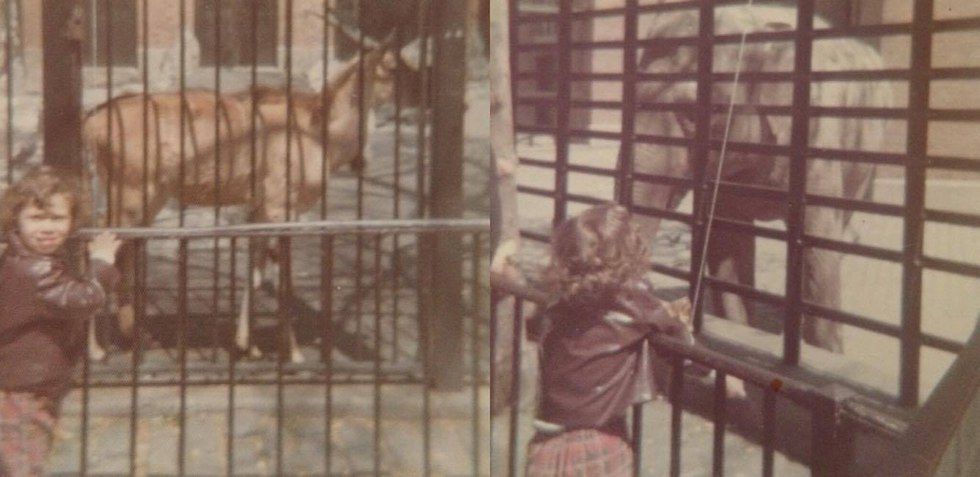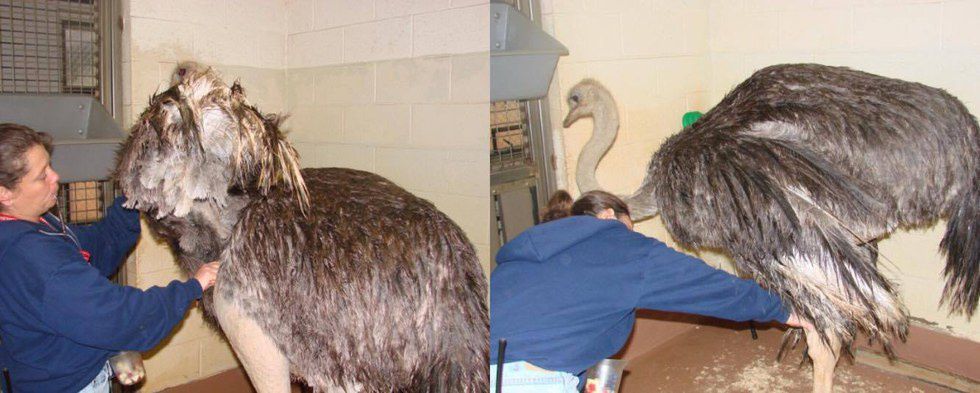My aunt, Dana Urbanski, has been a zookeeper for more than 21 years. Currently at the North Carolina Zoo, I visited her in Asheboro, North Carolina over the Memorial Day 2016 weekend and was able to get her perspective on what it is like to be a zookeeper in North America. My aunt’s case is a unique one, as she is someone who, before becoming a zookeeper, did not even know “zoo school” was an educational program in which an individual could enroll. Dana graduated undergrad from Old Dominion University in Norfolk, Virginia with a double major in Psychology and Counseling. Following graduation, she worked counseling homeless youth and disabled adults, among other communities in need of her services.
Becoming a Zoo Keeper in the Most Unlikely Way
As a child, Dana always loved zoos. A native of New York City, her uncles habitually took her to the Central Park Zoo and circuses. She owned stuffed animals, wanted to bring home strays, frogs, and lizards, and always was interested in being with and helping the animals in her own community.
During her Psych studies, Dana took an “animal behavior” class where she went to the Virginia Zoo to observe animals. She then started volunteering in Norfolk, and while there met a girl that went to Santa Fe Community College in Florida for “zoo school”. At the time, my aunt did not even know what “zoo school” was. Her love of animals and interest in animal behavior led her to apply to SFCC as well.
In December of 1995, Dana moved to Florida and began her 2- year path towards an Associate of Science degree in Zoo Animal Technology. Following graduation, she got a job at the Houston Zoo in Texas, and then later came back to the East Coast as an entry-level zookeeper at the North Carolina Zoo aviary. She worked with the birds for five years and then got a zookeeper position working with the zoo’s zebras, ostriches, giraffes, and red river hogs.
The Role of a Zookeeper
There since, my aunt deals with the husbandry of these animals.
She tends to their basic needs- when she comes to the zoo in the morning she sees to it that they are all up, standing, looking “good” and accounted for. She cleans their enclosures and gets them food, water, and medication if needed. If someone looks “off” or doesn’t look right, she contacts a supervisor so that appropriate steps can be taken. Daily reportings and taking care of animal barns and hay runs are also included in these needs.
Positive Reinforcement Training and Enrichment
Dana works with these animals via what she refers to as “positive reinforcement training”. If the animal does something right- in terms of allowing themselves to be touched by trainers and veterinarians for things like clipping nails, cleaning ears, trimming hooves, taking blood and ultrasounds or x- rays- they get a treat. All training is on a volunteer basis.
As my aunt says “every single little step is rewarded… they get a treat for it. It’s all voluntary, nothing forced. They could walk away and not train if they didn’t want to.”
Dana is also an expert in her field, as her best experience as a zookeeper to date stems from the training practices in place at NCZ. Her philosophy that “every animal can be trained,” from the “smartest” animal to even the smallest of birds, is evident in her successful training of three ostriches. The stereotype exists within the zoo community that these birds are stupid and untrainable.
“Why would you waste your time training them when you could just rodeo them or push them around with push boards so that vets could work with them?”
My aunt believes that any species of animal can be trained, “you just have to take the time to do it”. She came up with plans via her supervisor, training consultant, and vet so that stress levels for the birds, keepers and vets would be much lower through training. In her efforts to train the ostriches, she dispelled one of many zoo myths that some animals are too unintelligent or not worth the time it takes to be trained.
“It takes time. It takes a lot of time to train them and it takes so little time to get the task done. Every time you try to catch them instead of train them, it prolongs the process because now it takes longer to catch them. Do work at the beginning and get results at the end. Nowadays we are training everything. We train the animals, work with them, and are invested in their care.”
Thanks to Dana, the veterinarians can get a voluntary blood draw from wing veins without pushing them anywhere; they just feed them apples. The NCZ can now help the ostriches when injured, get voluntary x-rays and ultrasounds, and give medication- “put a pill in apple and they take it!”
“Enrichment” for the animals comes by giving them toys and activities to do which make them exhibit what Dana refers to as “natural behaviors”, or what you would find them doing in their natural habitat. Pigs get toys that prompt them to root around and use their noses, while giraffes get something to eat or lick.
From Zoo Goer to Zookeeper
As mentioned, Dana went to zoos often, but what she did not know was the cost of zoo and circus life to the animals themselves. Too young to understand, she did not know that “old- school” zoo practices in the 1960s- 80s had animals in small, concrete enclosures with minimal space and resources. Many circuses had unsafe ways of training their animals to “perform” for people. Circuses also brought animals all over the place in boxcars. At the time, Dana just liked the animal aspect of it all and later discovered the poor practices these institutions were utilizing.
Now, zoos have changed.
Zoo Misconceptions
“That the animals are all wild caught. In the old days they plucked them out of the wild, and we didn’t know and had to learn the hard way. Now, these animals have mostly never been in the wild. Most of them are all born in captivity and managed properly. We have a studbook keeper monitoring genetics so that animals have a recommendation to breed, and we have to be able to place them at another institution or zoo so that they can be ambassadors for their species, so that people can see them and we as zookeepers can educate them as to why they are so important. They don’t know anything else. You can’t just release them into the wild now. There might not be any “wild”- habitat- left for those bred in captivity. How is anybody going to ever love a giraffe from Africa if you’ve never seen one? Not everybody can go to Africa. It’s not just about “exhibiting” or “showing” these animals to the public, we love them and care about them. We want others to care about their conservation. We want people to care about them.
The Conservation Message of the North Carolina Zoo
As zookeepers, Dana and her peers have a duty to tell people about the circumstances of the animals in the wild and what people can do to help. The North Carolina Zoo has graphics and signs explaining history and background education on the animals on exhibit. “Key messages” on conservation and animal education are not a script- but a way “to feel visitors out and explain things to them.”
One vet for the zoo collared elephants for research in Africa to understand how they were using the land and develop ways to prevent human-animal conflict. The NCZ not only has people “on the ground” researching in Africa, but the institution also donates money for gorilla & giraffe projects. Additionally, proceeds from certain goods at the zoo’s gift shop go towards unique animal causes. The zoo also participates in “World ____ Day “ and has World lion and giraffe days, World Oceans Day and African Giants Day, among others, yearly. Dana, together with the zoo’s marketing department held a conservation day for giraffes. She and the horticulture staff discussed the conservation efforts relating to giraffes with visitors.
NCZ’s Conservation is its Best Reason To Visit
The North Carolina Zoo is the world’s largest natural habitat zoo.
“When they first built the zoo 40 years ago, they built habitats so that the visitors wouldn’t see moats, and wires, and chain links that would signal that that’s where the animals are enclosed. They wouldn’t see barns, just a beautiful natural landscape of these animals, and feel immersed like they are in an environment where the animals appear to be “roaming free””.
How You Can Get a Piece of Zoo Conservation Action
My aunt acknowledges that there are “tons of websites you can visit to donate money to certain projects, there are websites where you can look up a good conservation effort to donate to.”
http://www.saharaconservation.org/
http://www.girafferesearch.com/
http://www.reticulatedgiraffeproject.net/RGP/Home....
Also, you can get on Google, pick your favorite animal(s) and take up their cause as your own!
Knowing as a consumer what you are buying is also helpful to animals. Dana notes how buying ivory is not good for elephants, as they are being poached for their tusks. Procuring palm oil for products is harmful to various animal habitats. Certain types of shellfish that you buy in the supermarket are caught in harmful ways or are destroying ecosystems of other marine life. You don’t want to buy snakes and parrots that are being illegally captured in their native country and sold to others as pets.
Lastly, I highly recommend taking the road trip, flight, drive to the North Carolina Zoo to see all the beautiful animals, gorgeous scenery, and the attentive, caring people that foster the love and protection of wildlife, like Dana.
If you want to meet Dana and her long- necked friends, you can find them at the zoo’sAcacia Station Giraffe Deck/ Forest Edge Exhibit from April- October daily, 10 a.m. - 2 p.m.




















